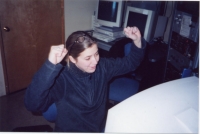
NUMBER OF STARS OBSERVED
AS OF DECEMBER 2003:
3,999

What objects to look at, and how to look at them, has been the subject of ongoing discussion in the SETI community. Early SETI experiments targeted solar type stars, since our solar system provides our only evidence so far of life in the universe. Numerous studies and computer simulations have taken place to determine habitable zones for each stellar type. These studies have shown that long lasting habitable zones, the region in which liquid water may exist on satellites around a parent star, are most probable around F, G, K, and M stars. These stars spend enough time on the main sequence to allow opportunity for intelligent life to develop.
As SETI moves into the 21st century, fewer assumptions on where to look for ETI are being made. The SETI community has gradually been opening up to new possibilities for search strategy and targets in the sky. Our group decided to equally target all stars with a presumed lifetime long enough to allow evolution of complex life. This strategy includes considerations of zones, main sequence lifetimes, and availability of materials (such as metals) that presumably would be needed for technological society.
Our stellar object list was derived from the Hipparcos Main Catalog with the following constraints: declination between -10 to +65 degrees, parallax greater than 16 milli-arcseconds (indicating that the star is no more than 200 lightyears from Earth) and a B-V color index between +0.3 and +1.5. The declination range is chosen based on telescope limitations and the observatory's latitude. We have decided to start our targeted optical search close to us, working our way out. Since the presumption is that a signal is being beamed deliberately toward us, civilizations closer to earth are more likely to know we are here and would more likely hail our attention. The B-V index was chosen specifically to yield the range of warmer F type stars to cooler M stars. With these constraints our star list yields 5,039 stars predominantly with spectral types F, G, K and M.
Operation
The telescope and instrument are operated from a nearby control room.
The operator is required to move the telescope between objects, control
the data-collection sequence, and monitor sky clarity.
Each observation is 10 minutes long, with each data file containing 6,000
samples at a readout rate of 100 milliseconds per sample. Therefore, there
are 6,000 lines written into the FITS file per object, with each line
recording the count levels from all seven counters.
|
|
||||||||